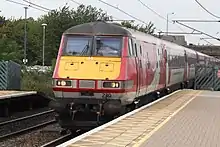Driving Van Trailer
A Driving Van Trailer (DVT) is a purpose-built control car railway vehicle that allows the driver to operate with a locomotive in push-pull formation from the opposite end of a train. Trains operating with a DVT consequently do not need the locomotive to be moved around to the other end of the train at terminal stations. Unlike many other control cars, DVTs resemble locomotives (specifically Class 91) and thus when the train is operating in push mode, it does not appear to be travelling backwards. The vehicles do not have any passenger accommodation due to health and safety rules in place at the time of building that prohibited passengers in the leading carriages of trains that run faster than 100 miles per hour (160 km/h). Historically, it was believed that a train would be unstable at high speeds unless pulled from the front but extensive testing, and the experience of high speed trains with central power cars such as the British Rail APT and the Eurostar, have altered this view.
| British Rail DVT | |
|---|---|
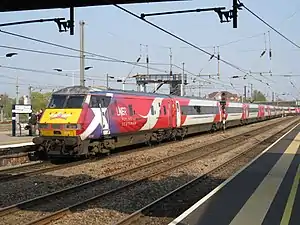 London North Eastern Railway Mark 4 DVT 82205 at Peterborough in April 2019 | |
| In service | 1989 – present |
| Manufacturer | Mark 3: British Rail Engineering Limited Mark 4: Metro-Cammell |
| Family name | |
| Constructed | 1988 - 1990 |
| Number built |
|
| Number in service |
|
| Number preserved |
|
| Number scrapped |
|
| Fleet numbers |
|
| Operator(s) | |
| Specifications | |
| Car length | 18.83 m (61 ft 9 in) |
| Width | 2.71 m (8 ft 11 in) |
| Height | 3.88 m (12 ft 9 in) |
| Maximum speed | 125 mph (201 km/h) (Mark 3) 140 mph (225 km/h) (Mark 4) |
| Weight | 43.7 t (43.0 long tons; 48.2 short tons) |
| Braking system(s) | Air |
| Track gauge | 1,435 mm (4 ft 8 1⁄2 in) standard gauge |
Development
The DVT concept is similar to the Mark 2 DBSO but unlike its predecessor, which was rebuilt from existing stock, it was a new build vehicle manufactured specifically for this purpose. The first design of DVT was designed to match Mark 2 and Mark 3 coaches. The second design has a narrower profile, similar to Mark 4 coaches, which would enable it to be converted to tilting operation if required in the future.
On the original Mark 3 DVTs, which operated on the West Coast Main Line, they used the RCH jumpers to carry the signals therefore allowing the same cables to be used for lighting and the public address system, as well as driver-guard signalling. The Class 86 and Class 87 locomotives had to be retrofitted with RCH cables, replacing the older in-class only multiple working jumpers.[1]
On the InterCity 225 sets operating on the East Coast Main Line, the Mark 4 DVTs and locomotives operate in push-pull formation utilising a time-division multiplexer to send control signals along specially screened cables which run the length of the train. The locomotives usually face away from London, only being changed occasionally in rare circumstances.
When a train is operated by a DVT, the control signals are encoded and multiplexed onto the cables by the TDM equipment in the DVT. At the locomotive, these signals are demultiplexed by the TDM equipment, and the signals are used to control the locomotive. The air braking system is operated directly from whichever cab the driver is driving from. If the TDM fails and cannot be reconfigured, the train may still operate, but if the DVT is leading, it will be necessary to uncouple the locomotive and attach it to the front of the train.
In addition to the driver's cab, some DVTs have luggage and cycle storage space and a guard's office. One DVT was fitted with a traction gel applicator.[2] A number of Mark 3 DVTs have been fitted with generators to provide power to on-train equipment. One has been fitted with traction equipment, becoming the experimental Class 19 locomotive.
Mark 3 DVT
InterCity West Coast
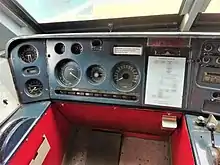
British Rail Engineering Limited's Derby Litchurch Lane Works built 52 Mark 3 DVTs to operate with Mark 2 and Mark 3 sets in push-pull mode with 86, 87 and 90 class locomotives on InterCity West Coast Main Line services from London Euston to Wolverhampton, Manchester, Liverpool and Glasgow allowing the retirement of the 81, 82, 83, 84 and 85 class locomotives. The standard practice was for the DVT to be marshaled at the southern end, adjacent to the first class carriages. The first was delivered in March 1989.[3]
They also operated between Wolverhampton and Shrewsbury, and between Crewe and Holyhead hauled by Class 47 diesel locomotives. Because these locomotives were not fitted with push-pull equipment, the 47s always operated leading.
As part of the privatisation of British Rail, all 52 were sold to Porterbrook in 1994 and were operated by InterCity West Coast franchise holder Virgin Trains West Coast from 1997 until the Mark 2 and Mark 3 sets were replaced by Class 390s between 2003 and 2005.[4] In 2002, Mark 3 DVTs operated beyond the West Coast Main Line on a summer Saturday service from Manchester to Paignton with a Class 47 hauled Mark 3 set that was hired to Virgin CrossCountry.
Following the loss of a Class 390 Pendolino in the Grayrigg derailment, a Mark 3 set with a Driving Van Trailer was leased with a Class 90 hired from English Welsh & Scottish as required. In 2008 Virgin looked at leasing two Class 180.[5] But decided to retain the Mark 3 set. Nicknamed the Pretendolino, this received re-upholstered seating, power points, wi-fi and a full external re-paint at Wabtec, Doncaster in 2009.[6] Virgin used this set with a Class 90 locomotive hired from Freightliner on a Euston to Crewe (via Birmingham) service on Fridays only until December 2012. From 9 December 2013 it was utilised to operate a London Euston -Birmingham New Street train on Thursdays and Fridays only, until its withdrawal in October 2014.
Greater Anglia
Mark 3 DVTs were introduced along with Mark 3 and Class 90s to the Greater Anglia franchise by National Express East Anglia operating on the Great Eastern Main Line from London Liverpool Street to Norwich in 2004. They also were hauled by Class 47s from Norwich to Great Yarmouth on summer Saturday services. It was proposed that kitchens be fitted to the DVTs, but this did not proceed.[7] All passed with the franchise to Greater Anglia in 2012.
In January 2020, the first Class 745s electric multiple units entered service.[8] The locomotive hauled sets were withdrawn from service, with the last set running on 24 March 2020.[9]
The standard practice was for the DVT to be marshaled at the eastern end, adjacent to the economy class carriages.[10]
Silverlink
From September 2004 until July 2005, Silverlink operated two DVTs in conjunction with Mark 3 and EWS Class 90s on peak hour London Euston to Northampton.[11][12]
DB Cargo UK
EWS purchased DVT 82146 to operate as part of its DB Cargo Company Train that was launched in December 2004.[13][14][15]
Hull Trains
In January 2008, DVT 82115 was hired to Hull Trains to operate services on the East Coast Main Line from London King's Cross to Doncaster with a set of Cargo-D Mark 3s while it was short of rolling stock.[16][17]
First ScotRail
During 2005 the Edinburgh - North Berwick Line services were operated by English Welsh & Scottish Class 90s with former Virgin Trains Mark 3 carriages and a Driving Van Trailer.
Wrexham & Shropshire
Wrexham & Shropshire started operating push-pull services with DVTs in October 2008 between London Marylebone and Wrexham General with Mark 3s and Class 67 diesel locomotives following the start of the service in April 2008 with Class 67s operating in top and tail formation. The DVTs required modification to work with the Class 67, involving adding a notched power controller as is used in the locomotive and a 27 wire jumper cable as used on the locomotives which is known as the AAR Multiple Working system. They were renumbered 82301 to 82305.[18][19]
With the reduction in service levels from December 2010, a Mark 3 set was hired to Chiltern Railways to operate a Birmingham Moor Street to London Marylebone peak-hour service.[20][21] The standard practice was for the DVT to be marshaled at the southern end.
Chiltern Railways
After Wrexham & Shropshire ceased in January 2011, its fleet of five DVTs were transferred to fellow DB Regio UK company Chiltern Railways and started operating on London Marylebone to Birmingham Snow Hill services with Mark 3s.[22] They were modified to work with the power doors that were fitted to the Mark 3 coaches and to have a generator fitted to enable Electric Train Supply and compressed air to be provided to the coaches when the locomotive is not running, such as when in a terminus station and when stabled.[23][24] Initially operated with Class 67s, since December 2014 they have operated with Class 68s.[25] Some peak services were extended to Kidderminster. A sixth DVT (82309) was leased to operate with a Mark 3 set on a peak hour service from London Marylebone to Banbury. The standard practice is for the DVT to be marshaled at the southern end.
Network Rail
In early 2013, several DVTs, including 82111, 82124, 82129 and 82145 were acquired by Network Rail and modified to work with diesel locomotives for use on test trains. Part of the modification work includes the integration of a diesel generator to provide power for on-board systems.[26]
Wales & Borders
In March 2012, three DVTs (82306-82308) were introduced along with Mark 3s and Class 67s on Arriva Trains Wales' Premier Service from Holyhead to Cardiff.[27][28] They also operate on services from Crewe and Manchester to Holyhead and Llandudno.[29] All passed with the Wales & Borders franchise to Transport for Wales in October 2018. All were withdrawn in July 2020.[30] In July 2020, 82306 and 82308 were sold to Rail Operations Group.[31]
Fleet list
| Key: | In service | Preserved | Stored | Scrapped | Other use |
|---|
| Original Number | New Number | Name | Operator / Owner | Livery | Status | Notes | Picture |
|---|---|---|---|---|---|---|---|
| 82101 | – | Wembley Depot Quality Approved‡ | Direct Rail Services[32] | Virgin Trains West Coast | Stored | Stored at Railway Technical Centre, Derby, no longer Network Rail registered | .jpg.webp) |
| 82102 | – | – | – | – | Scrapped | Scrapped by Sims, Newport May 2020 |  |
| 82103 | – | – | – | – | Scrapped | Fitted with experimental rail adhesion system (shown in image), scrapped by Sims, Newport May 2020 |  |
| 82104 | 82309 | – | Chiltern Railways | Chiltern Railways Mainline | In service | Fitted with ETS Generator | 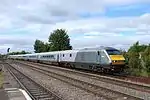 |
| 82105 | – | – | – | – | Scrapped | Scrapped by Sims, Newport May 2020 |  |
| 82106 | – | – | – | – | Scrapped | Scrapped by CF Booth, Rotherham February 2019[33] |  |
| 82107 | – | – | – | Greater Anglia | Stored | .jpg.webp) | |
| 82108 | 82308 | – | Rail Operations Group | Arriva Trains Wales | Stored |  | |
| 82109 | – | – | – | – | Scrapped | .jpg.webp) | |
| 82110 | – | – | – | Virgin Trains West Coast | Scrapped | Scrapped by CF Booth, Rotherham in 2019[33] Cab saved[34] | |
| 82111 | – | – | Network Rail | Network Rail yellow | In service | Modified for use on test trains[35] | |
| 82112 | – | – | – | Greater Anglia | Preserved | Owned by the Mid-Norfolk Railway. |  |
| 82113 | 19001 | – | – | Blue | Other use | Converted to Class 19 experimental vehicle at Bo'ness & Kinneil Railway.[36] | |
| 82114 | – | – | Northampton & Lamport Railway | Greater Anglia | Preserved | Preserved at the Northampton & Lamport Railway, will be fitted with an ETS Generator[37].Owned by the Northampton & Lamport Railway Charitable Incorporated Organisation (NLRCIO) |  |
| 82115 | – | Liverpool John Moores University‡ | – | BR Blue | Stored | Stored at Leicester |  |
| 82116 | – | – | – | – | Scrapped | Scrapped by CF Booth, Rotherham after store at Long Marston | |
| 82117 | 82301 | – | Chiltern Railways | Chiltern Railways Mainline | In service | Fitted with ETS Generator | .jpg.webp) |
| 82118 | – | Britannia‡ | Crewe Heritage Centre | Greater Anglia | Preserved | Donated for static display[38] | .jpg.webp) |
| 82119 | – | – | – | – | Scrapped | Scrapped at MoD Caerwent, 2005, due to extensive corrosion |  |
| 82120 | – | Liverpool Chamber of Commerce‡ | – | – | Scrapped | Scrapped by CF Booth, Rotherham after store at Long Marston | |
| 82121 | – | Carlisle Cathedral‡ | Colne Valley Railway | Greater Anglia | Preserved | Preserved at Colne Valley Railway[39] | .jpg.webp) |
| 82122 | – | – | – | – | Scrapped | Scrapped by CF Booth, Rotherham in 2019[33] |  |
| 82123 | – | – | – | – | Scrapped | Scrapped by CF Booth, Rotherham in 2019[33] | |
| 82124 | – | The Girls' Brigade‡ | Network Rail | Network Rail yellow | In service | Modified for use on test trains[40] |  |
| 82125 | – | – | Private Owner | Virgin Trains West Coast | Preserved | Used as a hauled carriage since 2019 at the Mid Norfolk Railway[41] |  |
| 82126 | – | Wembley Traincare Depot‡ | Direct Rail Services[32] | Virgin Trains West Coast silver | Stored | Stored at Railway Technical Centre, Derby, no longer Network Rail registered | .jpg.webp) |
| 82127 | - | Abraham Darby‡ | Locomotive Services Limited[42] | Greater Anglia | Stored | 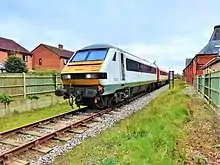 | |
| 82128 | – | – | – | – | Scrapped | Scrapped by CF Booth, Rotherham December 2012 | 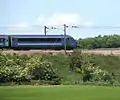 |
| 82129 | – | – | Network Rail | Network Rail yellow | In service | Modified for use on test trains[43] | |
| 82130 | 82304 | – | Chiltern Railways | Chiltern Railways Mainline | In service | Fitted with ETS Generator | .jpg.webp) |
| 82131 | 82307 | – | Transport for Wales | Arriva Trains Wales | Stored |  . . | |
| 82132 | – | West Midlands Industry '96‡ | – | – | Scrapped | Scrapped by Sims, Newport May 2020 | .jpg.webp) |
| 82133 | – | – | – | Greater Anglia | Preserved | Owned by the Mid-Norfolk Railway | |
| 82134 | 82305 | – | Chiltern Railways | Chiltern Railways Mainline | In service | Fitted with ETS Generator | .jpg.webp) |
| 82135 | 82303 | Spirit of Cumbria‡ | Chiltern Railways | Chiltern Railways Mainline | In service | Fitted with ETS Generator |  |
| 82136 | – | – | – | Greater Anglia |  | ||
| 82137 | – | – | – | – | Scrapped | Scrapped by CF Booth, Rotherham after store at Long Marston | |
| 82138 | – | – | – | Virgin Trains West Coast | Stored | Stored at Long Marston, no longer Network Rail registered | |
| 82139 | – | – | Locomotive Services Limited[42] | InterCity Swallow | Stored | .jpg.webp) | |
| 82140 | – | – | – | – | Scrapped | Scrapped by CF Booth, Rotherham January 2015 | |
| 82141 | – | – | – | – | Scrapped | Scrapped by CF Booth, Rotherham after store at Long Marston | |
| 82142 | – | – | – | – | Scrapped | ||
| 82143 | – | – | Greater Manchester Fire and Rescue Service | Greater Anglia | Other use | Training vehicle for fire-fighters | |
| 82144 | 82306 | – | Rail Operations Group | Arriva Trains Wales | Stored |  | |
| 82145 | – | – | Network Rail | Network Rail yellow | In service | Modified for use on test trains[44] | 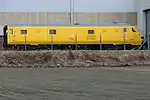 |
| 82146 | – | – | DB Cargo UK | DB Cargo UK silver | In service |  | |
| 82147 | – | The Red Devils‡ | – | – | Scrapped | ||
| 82148 | – | International Spring Fair‡ | – | – | Scrapped | Scrapped by CF Booth, Rotherham after store at Long Marston | |
| 82149 | – | 101 Squadron‡ | Fire Service College, Moreton-in-Marsh | Virgin Trains West Coast | Other use | Training vehicle for fire-fighters at Fire Service College, Moreton-in-Marsh[45] | |
| 82150 | – | – | – | Virgin Trains West Coast | Stored | Stored at Long Marston, no longer Network Rail registered | |
| 82151 | 82302 | – | Chiltern Railways | Chiltern Railways Mainline | In service | Fitted with ETS Generator. |  |
| 82152 | – | – | – | – | Scrapped | Scrapped by Sims, Newport May 2020 |  |
- ‡ – DVT has been denamed
Mark 4 DVT
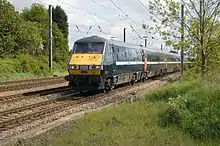
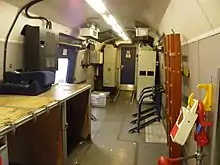
As part of the electrification of the East Coast Main Line from London King's Cross to Leeds, Edinburgh and Glasgow, 32 Mark 4 DVTs were built by Metro-Cammell, Washwood Heath for inclusion in InterCity 225 sets.[46] The bodyshells were manufactured under sub-contract by Breda in Italy.[47] They operate with class 91 locomotives using the TDM system via UIC screened cables through the nine Mark 4 coaches of the rake. They have also operated with 89 and 90 class locomotives.
InterCity East Coast
All entered service with InterCity. As part of the privatisation of British Rail, all 32 were sold to Eversholt Rail Group in 1994 and were operated by successive InterCity East Coast franchise holders GNER, National Express East Coast, East Coast, Virgin Trains East Coast and LNER. In February 2001, 82221 was damaged in the Great Heck rail crash and subsequently scrapped. The standard practice is for the DVT to be marshaled at the southern end, adjacent to the first class carriages.
With the delivery of Class 800 & Class 801, mass withdrawals commenced in May 2019.[48] Originally it was proposed that all the InterCity 225 sets be withdrawn by the end of 2020, but LNER decided to retain 10 sets until at least December 2021 to allow it to increase services.[49]
Grand Central
Grand Central would have used Mk4 coaches and DVTs on London Euston to Blackpool North services with Class 90 locomotives hauling six-carriage sets.[50][51][52] However these services were permanently abandoned on 10 September 2020.[53]
Transport for Wales
Transport for Wales is scheduled to introduce three four-car Mark 4 sets with Mark 4 DVTs on the Premier Service from Holyhead to Cardiff in 2021.[54][55]
Grand Union
Grand Union has proposed using Class 91 locomotives with Mk4 coaches and DVTs on its services from London Paddington to Cardiff Central and from London Euston to Stirling.[56][57]
Fleet list
| Key: | In service | Stored | Scrapped |
|---|
- ‡ – DVT has been denamed
Mark 5 DVT
The Mark 5 DVT was to be part of British Rail's ill-fated InterCity 250 project on the West Coast Main Line. This would have resembled the Class 93 locomotive, but contain a driving cab, seating for standard class passengers and a small guard compartment.
Accidents and incidents
DVTs have been involved in very few accidents.
- Hatfield rail crash, October 2000, involving DVT 82200.
- Great Heck rail crash, February 2001, involving DVT 82221 which was withdrawn and scrapped after major damage to the DVT.
See also
- Cab (locomotive)
- Control car (rail)
- Control stand
- Push–pull train
References
- Class History - AL6 / 86 Archived 8 September 2018 at the Wayback Machine AC Locomotive Group
- "Leaf it out!". Right Track (6): 5–91. November 2013. Archived from the original on 22 January 2019. Retrieved 10 May 2020.
- MkIII DVTs emerge The Railway Magazine issue 1056 April 1989 page 211
- After 31 years, 87s bow out on WCML passenger work Rail issue 516 22 June 2005 page 6
- Rail Magazine Issue 591 7 May 2008 Page 64
- Charter train potential for Virgin Trains 'new-look' loco-hauled trainset Archived 9 October 2011 at the Wayback Machine Virgin Trains Press Release 1 July 2009
- No Kitchen for One DVTs Rail issue 511 13 April 2005 page 25
- New Norwich-London inter-city 745 in traffic Rail issue 896 15 January 2020 page 10
- Geater, Paul. "End of the line for traditional trains on Greater Anglia routes". East Anglian Daily Times. Archived from the original on 31 March 2020. Retrieved 31 March 2020.
- Crowning glory Rail issue 543 5 July 2006 page 41
- Loco-hauled Cobblers to return from September The Railway Magazine issue 1240 August 2004 page 6
- The end for loco-hauled Cobbler services Entrain issue 45 September 2005 page 15
- EWS takes Porterbrook Mk 3 DVT for push-pull trains Rail issue 475 26 November 2003 page 7
- EWS boss creates promotional train Rail Express issue 100 September 2004 page 8
- EWS company train makes first run Rail issue 503 22 December 2004 page 7
- Preserved 86 enters service with Hull Trains Rail issue 584 30 January 2008 page 11
- Hull Trains replaces Class 86 with Class 180 The Railway Magazine issue 1286 June 2008 page 74
- Wrexham & Shropshire DVTs enter traffic The Railway Magazine issue 84 December 2008 page 68
- Wrexham & Shropshire DVTs enter traffic Today's Railways UK issue 84 December 2008 page 68
- Chiltern commence Birmingham loco-hauled Archived 16 October 2013 at the Wayback Machine Rail Express 14 December 2010
- Chiltern starts loco-hauled services The Railway Magazine issue 1318 February 2011 page 73
- Chiltern Mainline start-up Modern Railways issue 756 September 2011 page 6
- Chiltern DVTs get generators The Railway Magazine issue 1331 March 2012 page 78
- "Mk3 Vehicle Slam Door TSI-PRM Compliance Statement" (PDF). Archived (PDF) from the original on 30 November 2020. Retrieved 9 May 2020.
- Chiltern passenger debut for Class 68 Rail issue 764 24 December 2014 page 14
- Mackin, Rich (2017). Departmental Locomotives, Units and Coaching Stock. Amberley Publishing. p. 20. ISBN 9781445671260.
- Mk3 DVTs converted for Arriva Trains Wales Rail issue 687 11 January 2012 page 18
- 67s start work on WAG Express Rail issue 693 4 April 2012 page 25
- Locomotive-hauled traction in Wales Rail issue 761 12 November 2014 page 31
- Rhymney and WAG coaches stored Rail Express issue 290 July 2020 page 28
- Rail Operations Ltd acquires Welsh Mk3s Rail issue 911 12 August 2020 page 15
- Pretendolino Mk 3s removed ahead of TPE move Rail issue 807 17 August 2016 page 31
- Redundant Mk3s sent for scrapping Rail issue 873 27 February 2019 page 33
- "The Cab Yard, The South Wales Loco Cab Preservation Group". Archived from the original on 12 September 2019. Retrieved 15 May 2020.
- Mackin, Rich (15 October 2017). Departmental Locomotives, Units and Coaching Stock. Amberley Publishing Limited. p. 19. ISBN 1445671263.
- Wilkinson, Sarah (19 November 2018). "Class 19 on trial". Rail Express. Archived from the original on 23 September 2020. Retrieved 15 May 2020.
- Mark 3b Driving Van Trailer 82114 preserved at the Northampton & Lamport Railway Archived 16 June 2020 at the Wayback Machine Northampton & Lamport Railway
- "Two new exhibits to join the Heritage Centre". Archived from the original on 16 June 2020. Retrieved 9 May 2020.
- Train spotted in Halstead for first time in 50 plus years Archived 30 November 2020 at the Wayback Machine Essex County Standard 18 May 2020
- "82124 Network Rail Driving Van Trailer (DVT)". Archived from the original on 30 November 2020. Retrieved 17 May 2020.
- Preserved DVT to be restored Rail issue 864 24 October 2018 page 30
- LSL acquires Greater Anglia Mk3 stock Rail Express issue 286 March 2020 page 94
- "82129 Network Rail Driving Van Trailer (DVT)". Archived from the original on 26 August 2018. Retrieved 17 May 2020.
- "82145 Network Rail Driving Van Trailer (DVT)". Archived from the original on 30 November 2020. Retrieved 17 May 2020.
- "Image of 82149 at Fire Service College". Archived from the original on 13 November 2018. Retrieved 9 May 2020.
- Coach contracts shared The Railway Magazine issue 1031 March 1987 page 182
- Italians to build BR high speed coaches Railway Gazette International December 1988 page 792
- First LNER Mk4s taken to Worksop for storage Rail issue 880 5 June 2019 page 29
- Ten IC225s to remain with LNER until December 2021 Rail issue 899 26 February 2020 page 30
- 2020-02-20T16:48:00+00:00. "Grand Central prepares to launch London – Blackpool services". Railway Gazette International. Archived from the original on 24 February 2020. Retrieved 24 February 2020.
- Grand Central plans new Blackpool to London route from 2020 in major boost for the local economy Grand Central 24 June 2019
- Grand Central announces temporary suspension of train services during COVID-19 restrictions Grand Central 3 April 2020
- "Grand Central's planned Blackpool to London route falls victim to COVID-19 | Grand Central Rail". www.grandcentralrail.com. Archived from the original on 4 November 2020. Retrieved 10 September 2020.
- Welsh-bound Mk4s take to Eastleigh for use in five-car sets Rail issue 889 9 October 2019 page 32
- Transport for Wales notes Archived 13 January 2021 at the Wayback Machine North Wales Coast Railway Notice Board 11 January 2021
- [Application for Paddington-Cardiff open access trains Rail issue 877 24 April 2019 page 19
- Stirling in latest Grand Union access bid Rail issue 888 25 September 2019 page 16
- "Archived copy". Archived from the original on 30 November 2020. Retrieved 26 July 2020.CS1 maint: archived copy as title (link)
- The track obstruction by a road vehicle and subsequent train collisions at Great Heck 28 February 2001 (Report). Health and Safety Executive. February 2002. p. 15. ISBN 0-7176-2163-4.
External links
![]() Media related to Driving Van Trailers of Britain at Wikimedia Commons
Media related to Driving Van Trailers of Britain at Wikimedia Commons
.jpg.webp)
_(8961332809).jpg.webp)


.jpg.webp)



.jpg.webp)
.jpg.webp)



.jpg.webp)
.jpg.webp)
.jpg.webp)


.jpg.webp)
.JPG.webp)
.jpg.webp)


.jpg.webp)
